

Compact Muon Solenoid
LHC, CERN
| CMS-HIN-19-007 ; CERN-EP-2021-104 | ||
| Fragmentation of jets containing a prompt $\mathrm{J}/\psi$ meson in PbPb and pp collisions at $ {\sqrt {\smash [b]{s_{_{\mathrm {NN}}}}}} = $ 5.02 TeV | ||
| CMS Collaboration | ||
| 23 June 2021 | ||
| Phys. Lett. B 825 (2021) 136842 | ||
| Abstract: Jets containing a prompt $\mathrm{J}/\psi$ meson are studied in lead-lead collisions at a nucleon-nucleon center-of-mass energy of 5.02 TeV, using the CMS detector at the LHC. Jets are selected to be in the transverse momentum range of 30 $ < {p_{\mathrm{T}}} < $ 40 GeV. The $\mathrm{J}/\psi$ yield in these jets is evaluated as a function of the jet fragmentation variable $z$, the ratio of the $\mathrm{J}/\psi$ ${p_{\mathrm{T}}}$ to the jet ${p_{\mathrm{T}}}$. The nuclear modification factor, ${R_{\mathrm{AA}}} $, is then derived by comparing the yield in lead-lead collisions to the corresponding expectation based on proton-proton data, at the same nucleon-nucleon center-of-mass energy. The suppression of the $\mathrm{J}/\psi$ yield shows a dependence on $z$, indicating that the interaction of the $\mathrm{J}/\psi$ with the quark-gluon plasma formed in heavy ion collisions depends on the fragmentation that gives rise to the $\mathrm{J}/\psi$ meson. | ||
| Links: e-print arXiv:2106.13235 [hep-ex] (PDF) ; CDS record ; inSPIRE record ; HepData record ; CADI line (restricted) ; | ||
| Figures | |

png pdf |
Figure 1:
Projections of a two-dimensional fit used to extract the prompt ${\mathrm{J}/\psi}$ yield in PbPb collisions. Left : The dimuon invariant mass distribution. Right : The pseudo-proper decay length ($l_{{\mathrm{J}/\psi}}$) distribution. The fit functions are described in the text. The lower panels display the pull distributions, defined as the difference between the fit and the data, divided by the combined statistical uncertainty in the fit and in the data. |
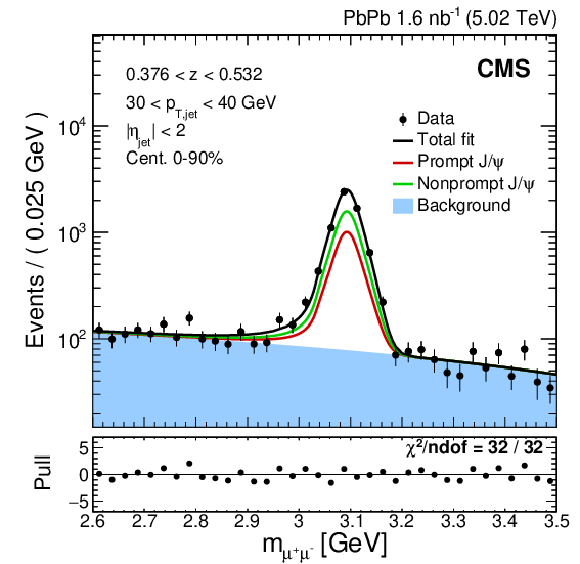
png pdf |
Figure 1-a:
The dimuon invariant mass distribution, together with the projection of a two-dimensional fit used to extract the prompt ${\mathrm{J}/\psi}$ yield in PbPb collisions. The fit functions are described in the text. The lower panel displays the pull distribution, defined as the difference between the fit and the data, divided by the combined statistical uncertainty in the fit and in the data. |
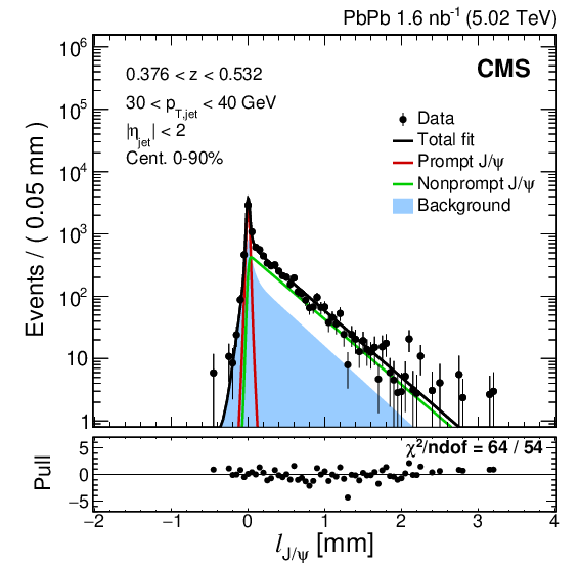
png pdf |
Figure 1-b:
The pseudo-proper decay length ($l_{{\mathrm{J}/\psi}}$) distribution, together with the projection of a two-dimensional fit used to extract the prompt ${\mathrm{J}/\psi}$ yield in PbPb collisions. The fit functions are described in the text. The lower panel displays the pull distribution, defined as the difference between the fit and the data, divided by the combined statistical uncertainty in the fit and in the data. |
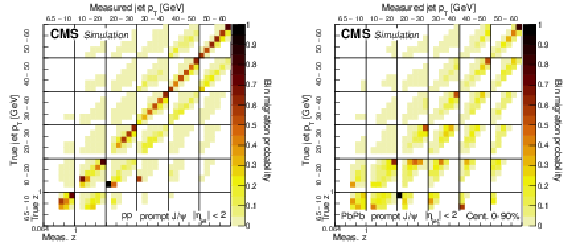
png pdf |
Figure 2:
Detector response matrices for jets containing a prompt ${\mathrm{J}/\psi}$ meson, showing the bin migration probability as a function of jet ${p_{\mathrm {T}}}$ and $z$. The response for pp collisions (left) is evaluated using PYTHIA 8. The response for PbPb collisions (right) is evaluated using PYTHIA 8 embedded into HYDJET. |

png pdf |
Figure 2-a:
Detector response matrices for jets containing a prompt ${\mathrm{J}/\psi}$ meson, showing the bin migration probability as a function of jet ${p_{\mathrm {T}}}$ and $z$. The response for pp collisions is evaluated using PYTHIA 8. |

png pdf |
Figure 2-b:
Detector response matrices for jets containing a prompt ${\mathrm{J}/\psi}$ meson, showing the bin migration probability as a function of jet ${p_{\mathrm {T}}}$ and $z$. The response for PbPb collisions is evaluated using PYTHIA 8 embedded into HYDJET. |

png pdf |
Figure 3:
The main sources of systematic uncertainty, as a function of $z$, for the cross section in pp (left) and the $T_{{\mathrm {AA}}}$-scaled yield in PbPb (right) collisions. The normalization uncertainties of 1.9% for pp and 2.6% for PbPb are not shown. |
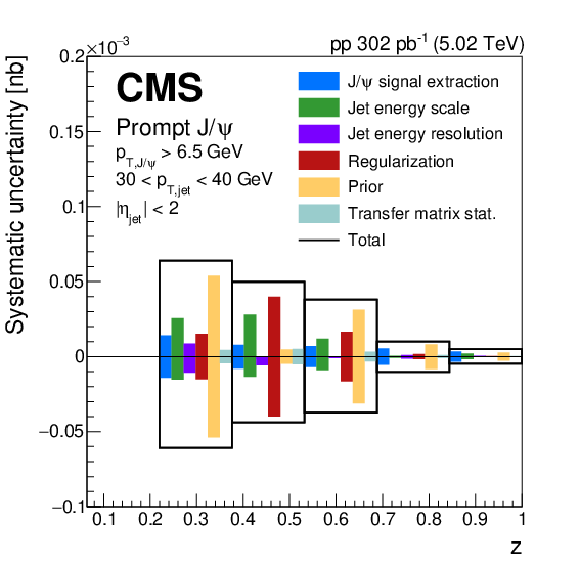
png pdf |
Figure 3-a:
The main sources of systematic uncertainty, as a function of $z$, for the cross section in pp collisions. The normalization uncertainty of 1.9% for pp is not shown. |
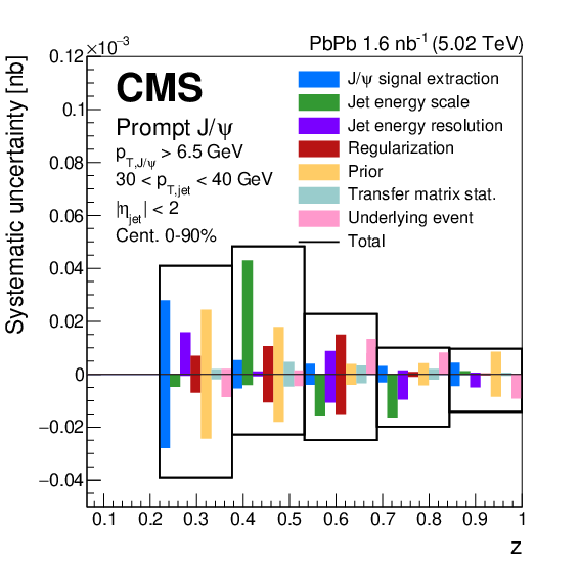
png pdf |
Figure 3-b:
The main sources of systematic uncertainty, as a function of $z$, for the $T_{{\mathrm {AA}}}$-scaled yield in PbPb collisions. The normalization uncertainty of 2.6% for PbPb is not shown. |

png pdf |
Figure 4:
Normalized $z$ distribution in pp collisions, compared to prompt and nonprompt ${\mathrm{J}/\psi}$ in PYTHIA 8, at the generator level. Bars indicate statistical uncertainties, while systematic uncertainties are depicted as boxes. |

png pdf |
Figure 5:
Left : The ${\mathrm{J}/\psi}$ differential cross section in pp and the $T_{{\mathrm {AA}}}$-scaled yield in PbPb collisions, as a function of $z$. The normalization uncertainties of 1.9% for pp and 2.6% for PbPb are not included in the point-by-point uncertainty boxes and not shown in the plot. Right : The nuclear modification factor ${R_ {\mathrm {AA}}}$, as a function of $z$. Bars indicate statistical uncertainties, while systematic uncertainties are depicted as boxes. The box around unity shows the normalization uncertainty. |
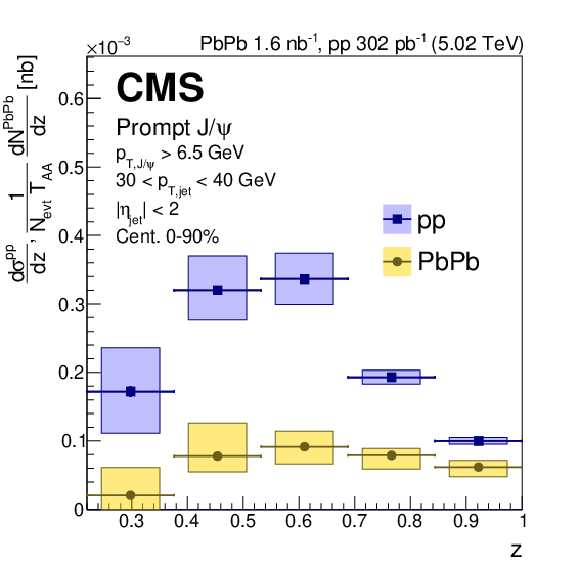
png pdf |
Figure 5-a:
The ${\mathrm{J}/\psi}$ differential cross section in pp and the $T_{{\mathrm {AA}}}$-scaled yield in PbPb collisions, as a function of $z$. The normalization uncertainties of 1.9% for pp and 2.6% for PbPb are not included in the point-by-point uncertainty boxes and not shown in the plot. |

png pdf |
Figure 5-b:
The nuclear modification factor ${R_ {\mathrm {AA}}}$, as a function of $z$. Bars indicate statistical uncertainties, while systematic uncertainties are depicted as boxes. The box around unity shows the normalization uncertainty. |

png pdf |
Figure 6:
The nuclear modification factor ${R_ {\mathrm {AA}}}$ for two centrality selections of PbPb collisions, as a function of $z$. Due to limited statistical precision, the lowest $z$ bin is excluded. Bars indicate statistical uncertainties, while systematic uncertainties are depicted as boxes. The boxes around unity show the normalization uncertainties. |
| Summary |
| Jets containing a prompt $\mathrm{J}/\psi$ meson were studied in proton-proton (pp) and lead-lead (PbPb) collisions at $ {\sqrt {\smash [b]{s_{_{\mathrm {NN}}}}}} = $ 5.02 TeV, for jets with transverse momentum 30 $ < {p_{\mathrm{T}}} < $ 40 GeV and pseudorapidity $|\eta| < $ 2. The distribution of the fragmentation variable $z$, the ratio of the $\mathrm{J}/\psi$ ${p_{\mathrm{T}}}$ to that of the jet, was measured in both systems. In pp collisions, prompt $\mathrm{J}/\psi$ mesons were found to have more surrounding jet activity, i.e., , to populate lower values of $z$ than predicted by PYTHIA 8 simulations, suggesting that $\mathrm{J}/\psi$ production late in the parton shower is underestimated. The pp and PbPb distributions were compared by calculating the nuclear modification factor, ${R_{\mathrm{AA}}} $, the ratio of PbPb data to the expectation based on pp data. The value of ${R_{\mathrm{AA}}} $ as a function of $z$ shows a rising trend. The suppression at low $z$ is found to be larger in the 20% most central events (i.e., "head-on'' collisions), as compared to the less central selection. The results show explicitly that the $\mathrm{J}/\psi$ produced with a large degree of surrounding jet activity are more highly suppressed than those produced in association with fewer particles. This finding emphasizes the importance of incorporating the jet quenching mechanism in models of $\mathrm{J}/\psi$ suppression. |
| References | ||||
| 1 | T. Matsui and H. Satz | $ \mathrm{J}/\psi $ suppression by quark-gluon plasma formation | PLB 178 (1986) 416 | |
| 2 | P. Braun-Munzinger and J. Stachel | (Non)thermal aspects of charmonium production and a new look at $ J/\psi $ suppression | PLB 490 (2000) 196 | nucl-th/0007059 |
| 3 | ALICE Collaboration | $ \mathrm{J}/\psi $ suppression at forward rapidity in PbPb collisions at $ {\sqrt {\smash [b]{s_{_{\mathrm {NN}}}}}} = $ 2.76 TeV | PRL 109 (2012) 072301 | 1202.1383 |
| 4 | NA50 Collaboration | Evidence for deconfinement of quarks and gluons from the $ \mathrm{J}/\psi $ suppression pattern measured in Pb+Pb collisions at the CERN SPS | PLB 477 (2000) 28 | |
| 5 | PHENIX Collaboration | $ \mathrm{J}/\psi $ suppression at forward rapidity in AuAu collisions at $ {\sqrt {\smash [b]{s_{_{\mathrm {NN}}}}}} = $ 200 GeV | PRC 84 (2011) 054912 | 1103.6269 |
| 6 | LHCb Collaboration | Study of $ \mathrm{J}/\psi $ production in jets | PRL 118 (2017) 192001 | 1701.05116 |
| 7 | R. Bain et al. | NRQCD confronts LHCb data on quarkonium production within jets | PRL 119 (2017) 032002 | 1702.05525 |
| 8 | T. Sjostrand et al. | An introduction to PYTHIA 8.2 | CPC 191 (2015) 159 | 1410.3012 |
| 9 | CMS Collaboration | Study of J/$ \psi $ meson production inside jets in pp collisions at $ \sqrt{s} = $ 8 TeV | PLB 804 (2020) 135409 | CMS-BPH-15-003 1910.01686 |
| 10 | F. Arleo | Quenching of hadron spectra in heavy ion collisions at the LHC | PRL 119 (2017) 062302 | 1703.10852 |
| 11 | CMS Collaboration | Measurement of prompt and nonprompt charmonium suppression in PbPb collisions at 5.02 TeV | EPJC 78 (2018) 509 | CMS-HIN-16-025 1712.08959 |
| 12 | ATLAS Collaboration | Prompt and non-prompt $ J/\psi $ and $ \psi (2\mathrm {S}) $ suppression at high transverse momentum in 5.02 TeV Pb+Pb collisions with the ATLAS experiment | EPJC 78 (2018) 762 | 1805.04077 |
| 13 | CMS Collaboration | Charged-particle nuclear modification factors in PbPb and pPb collisions at $ {\sqrt {\smash [b]{s_{_{\mathrm {NN}}}}}} = $ 5 TeV | JHEP 04 (2017) 039 | CMS-HIN-15-015 1611.01664 |
| 14 | Y.-T. Chien et al. | Jet Quenching from QCD Evolution | PRD 93 (2016) 074030 | 1509.02936 |
| 15 | J. Casalderrey-Solana et al. | A hybrid strong/weak coupling approach to jet quenching | JHEP 10 (2014) 019 | 1405.3864 |
| 16 | E. Bianchi et al. | The $ x $ and $ Q^2 $ dependence of $ \hat{q} $, quasi-particles and the JET puzzle | 1702.00481 | |
| 17 | J. Xu, J. Liao, and M. Gyulassy | Bridging soft-hard transport properties of quark-gluon plasmas with CUJET3.0 | JHEP 02 (2016) 169 | 1508.00552 |
| 18 | C. Andrés et al. | Energy versus centrality dependence of the jet quenching parameter $ \hat{q} $ at RHIC and LHC: a new puzzle? | EPJC 76 (2016) 475 | 1606.04837 |
| 19 | J. Noronha-Hostler, B. Betz, J. Noronha, and M. Gyulassy | Event-by-event hydrodynamics $ + $ jet energy loss: A solution to the $ R_\mathrm{AA} \otimes v_2 $ puzzle | PRL 116 (2016) 252301 | 1602.03788 |
| 20 | CMS Collaboration | Suppression and azimuthal anisotropy of prompt and nonprompt $ {\mathrm{J}}/\psi $ production in PbPb collisions at $ \sqrt{{s_{_{\text {NN}}}}} = $ 2.76 TeV | EPJC 77 (2017) 252 | CMS-HIN-14-005 1610.00613 |
| 21 | M. L. Miller, K. Reygers, S. J. Sanders, and P. Steinberg | Glauber modeling in high-energy nuclear collisions | Ann. Rev. Nucl. Part. Sci. 57 (2007) 205 | nucl-ex/0701025 |
| 22 | CMS Collaboration | Performance of the CMS muon detector and muon reconstruction with proton-proton collisions at $ \sqrt{s} = $ 13 TeV | JINST 13 (2018) P06015 | CMS-MUO-16-001 1804.04528 |
| 23 | CMS Collaboration | The CMS trigger system | JINST 12 (2017) P01020 | CMS-TRG-12-001 1609.02366 |
| 24 | CMS Collaboration | Particle-flow reconstruction and global event description with the CMS detector | JINST 12 (2017) P10003 | CMS-PRF-14-001 1706.04965 |
| 25 | CMS Collaboration | The CMS experiment at the CERN LHC | JINST 3 (2008) S08004 | CMS-00-001 |
| 26 | CMS Collaboration | Extraction and validation of a new set of CMS PYTHIA8 tunes from underlying-event measurements | EPJC 80 (2020) 4 | CMS-GEN-17-001 1903.12179 |
| 27 | P. Nason et al. | Bottom production | in Workshop on Standard Model Physics (and more) at the LHC (First Plenary Meeting), p. 231 1999 | hep-ph/0003142 |
| 28 | I. P. Lokhtin and A. M. Snigirev | A model of jet quenching in ultrarelativistic heavy ion collisions and high-$ {p_{\mathrm{T}}} $ hadron spectra at RHIC | EPJC 45 (2006) 211 | hep-ph/0506189 |
| 29 | GEANT Collaboration | GEANT4 --- A simulation toolkit | NIMA 506 (2003) 250 | |
| 30 | M. J. Oreglia | A study of the reactions $\psi' \to \gamma\gamma \psi$ | PhD thesis, Stanford University, 1980 SLAC Report SLAC-R-236, see A | |
| 31 | Particle Data Group Collaboration | Review of Particle Physics | PRD 98 (2018) 030001 | |
| 32 | M. Pivk and F. R. Le Diberder | sPlot: A statistical tool to unfold data distributions | NIMA 555 (2005) 356 | physics/0402083 |
| 33 | CMS Collaboration | Performance of CMS muon reconstruction in pp collision events at $ \sqrt{s} = $ 7 TeV | JINST 7 (2012) P10002 | CMS-MUO-10-004 1206.4071 |
| 34 | M. Cacciari, G. P. Salam, and G. Soyez | The anti-$ {k_{\mathrm{T}}} $ jet clustering algorithm | JHEP 04 (2008) 063 | 0802.1189 |
| 35 | M. Cacciari, G. P. Salam, and G. Soyez | FastJet user manual | EPJC 72 (2012) 1896 | 1111.6097 |
| 36 | CMS Collaboration | Jet energy scale and resolution in the CMS experiment in pp collisions at 8 TeV | JINST 12 (2017) P02014 | CMS-JME-13-004 1607.03663 |
| 37 | P. Berta, M. Spousta, D. W. Miller, and R. Leitner | Particle-level pileup subtraction for jets and jet shapes | JHEP 06 (2014) 092 | 1403.3108 |
| 38 | G. D'Agostini | A multidimensional unfolding method based on Bayes' theorem | NIMA 362 (1995) 487 | |
| 39 | T. Adye | Unfolding algorithms and tests using RooUnfold | in PHYSTAT 2011, Workshop on Statistical Issues Related to Discovery Claims in Search Experiments and Unfolding, CERN Yellow Reports, 2011 | 1105.1160 |
| 40 | CMS Collaboration | Luminosity measurement in proton-proton collisions at 5.02 TeV in 2017 at CMS | CMS-PAS-LUM-19-001 | CMS-PAS-LUM-19-001 |
| 41 | S. van der Meer | Calibration of the effective beam height in the ISR | CERN-ISR-PO/68-31 | |
| 42 | C. Loizides, J. Kamin, and D. d'Enterria | Improved Monte Carlo Glauber predictions at present and future nuclear colliders | PRC 97 (2018) 054910 | 1710.07098 |
| 43 | P. Caucal, E. Iancu, A. H. Mueller, and G. Soyez | Vacuum-like jet fragmentation in a dense QCD medium | PRL 120 (2018) 232001 | 1801.09703 |

|
Compact Muon Solenoid LHC, CERN |

|

|

|

|

|

|